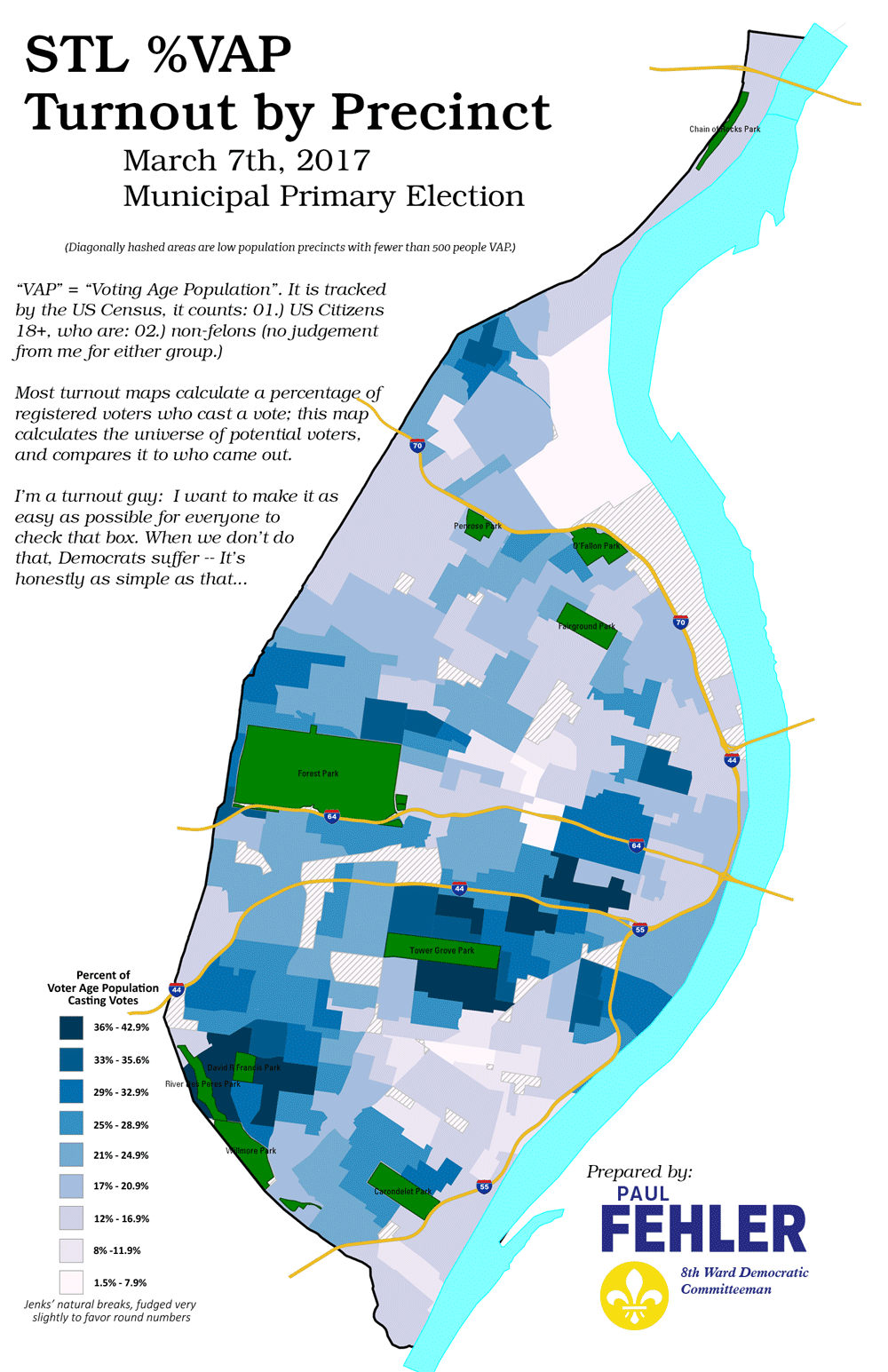Following the March 7 St. Louis City Democratic mayoral primary, we posted maps by Paul Fehler, 8th Wards Democratic Committeeman (Understanding St. Louis: Democratic Mayoral Primary Results – 2017). Visualizing the votes by ward in what was essentially a four-way contest, revealed somewhat expected patterns of support. Notes on the primary vote are below. Now Paul has put together maps showing voting by precinct for eacy Democratic candidate. These offer a more fine-grained look at voting patterns.
From Paul Fehler:
By tradition turnout numbers have always been delivered as a percentage of “who shows up” out of “who’s registered (and active) to vote” – but that’s a terrible yardstick and always has been. Demographers use different number: the Census calls it “VAP” and it stands for “Voting Age Population”, the universe for VAP is: all people 18+ who are U.S. Citizens and are non-felons*. In other words: everyone who COULD vote if they wanted to.
Maps are 2016 (4Q) ACS data blended with 2010 USC shapefiles informed by STL BoE “by precinct” data release. Breaks are “Jenk’s Natural” fudged for round numbers. Any transcription errors are my own (and please point them out).
Notes from Understanding St. Louis: Democratic Mayoral Primary Results – 2017:
28th Ward Alderwoman Lyda Krewson is likely to be the next mayor of the City of St. Louis. She would be the city’s first new mayor in 16 years, following the record four-term run on Francis Slay. She would also be the first woman mayor in the city’s 253-year history.
With a deep field of legitimate contenders, untangling the path to victory is more difficult than the 2013 two-up contest between Slay and President of the Board of Aldermen Lewis Reed. The total margin of victory for Krewson was just 888 votes. Vote totals: Krewson 17,110 / Jones 16,222 / Reed 9,775 / French 8,460 / Boyd 1,429.
In 2013, Slay earned 23,968 votes to Reed’s 19,496, a margin of 4,472 and just more than 10%. In that contest, Slay reached nearly 70% of total votes in a dozen wards (Read: Understanding St. Louis: Democratic Mayoral Primary Results – 2013). Turnout was recorded as 22.08%. 2017 voter turnout was 28.36%, a 28% increase.
Notes on election results, and maps by NEXT STL and Paul Fehler (click images to enlarge):
Victor Lyda Krewson topped 50% of the vote in just four of the city’s 28 wards. That may not sound impressive, but among the next three challengers, who split 64.53% of the vote, that number was reached just once in 84 opportunities. City Treasurer Tishaura Jones garnered 53.38% of the 15th Ward ballots.
President of the Board of Aldermen Lewis Reed was the top vote getter in five wards: 2nd, 3rd, 4th, 19th, and 27th, reaching his highest percentage of 34.77% in the 4th. 21st Ward Alderman Antonio French won just one ward, his own (a seat he is set to vacate), with 36.65% of the vote there.
The lopsidedness of votes is fairly drastic. Krewson’s percent of votes by ward ranges from 64.83% (16th) to 4.12% (22nd). There were six wards where Krewson failed to gain more than 6.5% of the vote, and six more where she failed to reach 20%. The spread for Jones is from 53.38% (15th) to 12.05% (16th). Reed and French, who trailed by significant margins, each earned less than 10% in just three wards.
There are plenty of “what-ifs” in a close election, but if we look at Krewson v. Not Krewson (Jones+Reed+French)? Krewson wins just five wards and loses 13 by more than a 50% margin. Krewson and Jones split wards with the highest voter turnout, each winning five of the top 10 wards by voter participation.
Jones beat Krewson in 18 of the city’s 28 wards. Krewson key to victory was dominating the 12th, 16th, 23th, and 28th Wards, piling up a margin of 4,696 votes. By contrast, Jones’s best four wards provided a 2,153 margin over Krewson. In those wards, Reed and French grabbed 2,943 total votes.








